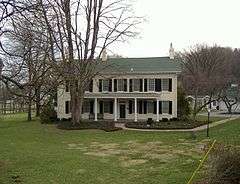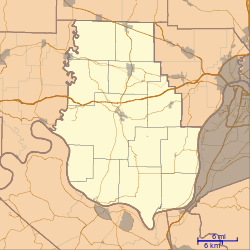Kintner-McGrain House
|
Kintner-McGrain House | |
 | |
   | |
| Location | 740 N. Capital Ave., Corydon, Indiana |
|---|---|
| Coordinates | 38°13′5″N 86°7′33″W / 38.21806°N 86.12583°WCoordinates: 38°13′5″N 86°7′33″W / 38.21806°N 86.12583°W |
| Area | 2.2 acres (0.89 ha) |
| Built | 1808 |
| Architectural style | Federal |
| NRHP Reference # | 83000032[1] |
| Added to NRHP | August 3, 1983 |
The Kintner-McGrain House, also known as Cedar Glade, is on the National Register of Historic Places, located north of downtown Corydon, Indiana. It attained the "Cedar Glade" name due to the giant red cedars Jacob Kinter, the builder, planted in front of the house. It has been owned by three different families: Kintners (1808), McGrains(1849), and Bennetts (1998). It is the second-oldest building in Harrison County, Indiana. It was built in 1808, and is a Late Federal/Early Republic Style, "L"-shaped, brick dwelling. During John Hunt Morgan's raid in 1863, noncombatants took refuge in the house. Ironically, several cannonballs landed in the front yard. Until 1946 it was a working farm.[2]
It was added to the National Register of Historic Places in 1983.[1]
See also
References
- 1 2 National Park Service (2010-07-09). "National Register Information System". National Register of Historic Places. National Park Service.
- ↑ "Indiana State Historic Architectural and Archaeological Research Database (SHAARD)" (Searchable database). Department of Natural Resources, Division of Historic Preservation and Archaeology. Retrieved 2016-04-01. Note: This includes Thomas D. McGrain (January 1982). "National Register of Historic Places Inventory Nomination Form: Kintner-McGrain House" (PDF). Retrieved 2016-04-01. and Accompanying photographs.


